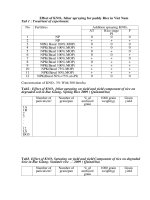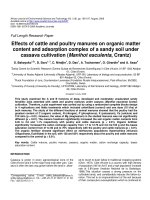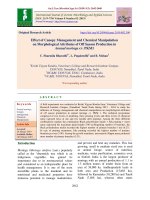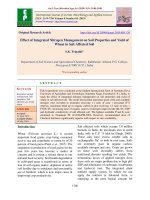Effect of weed management in yield attributes of Manihot Esculenta Crantz (Cassava)
Bạn đang xem bản rút gọn của tài liệu. Xem và tải ngay bản đầy đủ của tài liệu tại đây (200.23 KB, 5 trang )
Int.J.Curr.Microbiol.App.Sci (2019) 8(3): 2514-2518
International Journal of Current Microbiology and Applied Sciences
ISSN: 2319-7706 Volume 8 Number 03 (2019)
Journal homepage:
Original Research Article
/>
Effect of Weed Management in Yield Attributes of
Manihot esculenta Crantz (Cassava)
S. Krishnaprabu*
Department of Agronomy, Faculty of Agriculture, Annamalai University, Annamalai Nagar,
Annamalai Nagar, Chidambaram 608 002, Tamil Nadu, India
*Corresponding author
ABSTRACT
Keywords
Cassava
Manihot esculenta
Tuber yield
Weed management
Weedicides
Article Info
Accepted:
25 May 2018
Available Online:
10 June 2018
Weed management in farmer’s cassava (Manihot esculenta Crantz) field was carried out
during 2017 to assess the weed control and yield characteristics of cassava in eight
different treatments (T1-T8) including weedy check which served as control. The
treatments consisted of weedy check (control, T1), weed free (hand weeding as and when
required, T2), pendimethalin @ 1.5 kg/ha (T3), pendiplus @ 1.50 kg/ha (T4), imazethapyr
@ 80g/ha (T5), pendimethalin @ 1.5 kg/ha + hoeing and earthing up (60 DAP) (T6),
pendiplus @ 1.50 kg/ha + hoeing and earthing up (60 DAP) (T7) and imazethapyr @
80g/ha + hoeing and earthing up (60 DAP) (T8). The abundant weeds in the field were
Boerhavia diffusa, Cyperus rotundus, Cyanodon dactylon, Phyllanthus maderaspatensis,
Chloris barbata and Euphorbia hirta. The yield performance was higher in T2 followed by
T6, T3, T8 and T7 where the tuber yield was 23759.46, 22758.17, 22408.53, 21284.60 and
20618.76 kg/ha respectively.
Introduction
In tropical regions, cassava (Manihot
esculenta Crantz) plays an important role in
food security and poverty alleviation (Parkes
et al., 2013). Cassava is rich in carbohydrates
and sustainably contributes to nourish millions
of people because of its availability over the
year (Hongbété et al., 2011; Sanoussi et al.,
2015). Many elite varieties have been
identified and used worldwide (Gbessovi et
al., 2016; Kombate et al., 2017). Weed
management in agriculture is very important
and difficult task for all kinds of crops (Dash
et al., 2018; Kumar et al., 2018). The present
scenario of high wages of labourers and also
its scarcity particularly during peak periods
and drudgery it seems to be imperative to go
for chemical weed control due to its edge over
manual weeding to overcome these problems
(Singh et al., 2018). Aiyelari et al., (2017)
concluded that although application of diuron
at 2.25 kg a.i ha-1 gave the optimum weed
control, it may be necessary to tank mix
diuron at reduced rate with other compatible
herbicides to broaden the spectrum of weed
control.
Weed competition is one of the most
important factors in limiting the yield of crops.
2514
Int.J.Curr.Microbiol.App.Sci (2019) 8(3): 2514-2518
The effective control of weeds in rice could be
achieved with pre-emergence herbicide use of
pretilachlor, penoxsulam and pyrazosulfuron.
Among the post emergence herbicides use of
chlorimuron-ethyl + metsulfuron-methyl,
ethoxysulfuron, bispyribac sodium gives
promising results (Kabdal et al., 2018). From
this study, it could be concluded that under
transplanted rice in sodic soil, pre emergence
application of bensulfuron methyl +
pretilachlor at 60 + 600 g a.i. ha-1 on 3 DAT fb
hand weeding on 40 DAT resulted in
increased yield attributes and nutrient uptake
by rice. In cassava, it has been reported that
weed control by hoe weeding and earthing up
alone may increase the cost of production
because of higher labour requirement.
However, it was better to practice application
of pre emergent herbicides like pendimethalin
along with hoeing and earthing up at 60 DAP
for effective weed control and reduction in
cost of cultivation (Reshma et al., 2016). In
the present study, the chemical weed control
with
pendimethalin,
imazethapyr
and
pendiplus on pre-emergence application,
hoeing and earthing up after 60 days have
been studied to find out the different
treatments on yield characteristics of cassava
and weed control in farmer’s field.
Materials and Methods
The experiment was carried out at the local
farmer’s field using the experimental design
adopted was randomized block design (RBD)
with eight treatments and three replications.
The treatments consisted of weedy check
(control, T1), weed free (hand weeding as and
when required, T2), pendimethalin @ 1.5
kg/ha (T3), pendiplus @ 1.50 kg/ha (T4),
imazethapyr @ 80g/ha (T5), pendimethalin @
1.5 kg/ha + hoeing and earthing up (60
DAP)(T6), pendiplus @ 1.50 kg/ha + hoeing
and earthing up (60 DAP) (T7) and
imazethapyr @ 80g/ha + hoeing and earthing
up (60 DAP) (T8). Vermicompost @ 6.5 t/ha
was applied basally at the time of land
preparation. Nitrogen, phosphate and potash
@ 100:100:100 kg/ha was applied in three
splits, at land preparation and two and three
months after planting. The hoeing and
earthing up was done 60 DAP. The crop was
harvested after six months after planting and
the yield characteristics and final weed
numbers were counted and the data were
subjected to analysis of variance (ANOVA).
Benefit –cost ration (BCR) was worked out
based on the prevailing market price.
Results and Discussion
The results on the yield characteristics of
cassava in different treatments are shown in
Table 1. The lowest yield of 11610.15 kg/ha
was recorded in T1. A maximum yield
performance was found in T2 followed by T6,
T3, T8 and T7 where the tuber yield was
23759.46, 22758.17, 22408.53, 21284.60 and
20618.76 kg/ha respectively. The total number
of tubers per plant was 8.72 in T2 followed by
8.21 in T7 which received pendiplus @ 1.50
kg/ha + hoeing and earthing up (60 DAP). The
length of the tuber was 45.91 cm in Weed free
(Hand weeding as and when required, T2),
followed by T7 [pendiplus @ 1.50 kg/ha +
hoeing and earthing up (60 DAP)]> 43.58 in
T8 which received imazethapyr @ 80g/ha +
hoeing and earthing up (60 DAP). The BCR
ranged from 1.22 – 2.33 in the treatments. The
BCR was 1.22, 1.73, 2.03, 1.82, 1.80, 2.33,
1.93 and 2.23 respectively in T1, T2, T3, T4,
T5, T6, T7 and T8 respectively. The results
showed that the hand weeding treatment had
effective yield characteristics and very closely
followed by pendimethalin @ 1.5 kg/ha with
pre-emergence application (T3). The weed
count at harvest showed greater reduction in
the treatments T8 and T6 followed by other
treatments (Fig. 1).
2515
Int.J.Curr.Microbiol.App.Sci (2019) 8(3): 2514-2518
Table.1 Effect of different treatments on yield characteristics of cassava and weed count
Treatments
T1
T2
T3
T4
T5
T6
T7
T8
Weedy check (Control)
Weed free (Hand weeding as and
when required)
Pendimethalin @ 1.5 kg/ha (PRE)
Pendiplus @ 1.50 kg/ha (PRE)
Imazethapyr @ 80g/ha (PRE)
Pendimethalin @ 1.5 kg/ha +
Hoeing and earthing up (60 DAP)
Pendiplus @ 1.50 kg/ha + Hoeing
and earthing up (60 DAP)
Imazethapyr @ 80g/ha + Hoeing
and earthing up (60 DAP)
No. of
tubers/plant
4.56
8.72
Length of
tuber (cm)
23.82
45.91
Yield
(kg/ha)
11610.15
23759.46
BCR
7.60
6.89
7.20
7.60
39.02
35.67
33.75
40.54
22408.53
19354.98
19762.39
22758.17
2.03
1.82
1.80
2.33
8.21
45.61
20618.76
1.93
7.90
43.58
21284.60
2.23
Table.2 Commonly found weeds of cassava field
Sl. No.
1.
2.
3.
4.
5.
6.
7.
8.
9.
10.
11.
12.
13.
14.
15.
16.
17.
18.
19.
20.
Name of the weed
Family
Almania nodiflora
Alternanthera pungens
Boerhaavia diffusa
Cenchrus ciliaris
Chloris barbata
Cyanodon dactylon
Cyperus rotundus
Dactyloctenium aegypticum
Digera muricata
Euphorbia hirta
Glinus lotoides
Oldenlandia corymbosa
Phyllanthus amarus
Phyllanthus maderaspatensis
Portulaca oleraceae
Spermacoce hispida
Trianthema portulacastrum
Tribulus terrestris
Trichodesma indicum
Tridax procumbens
Amaranthaceae
Amaranthaceae
Nyctaginaceae
Poaceae
Poaceae
Poaceae
Cyperaceae
Poaceae
Amaranthaceae
Euphorbiaceae
Molluginaceae
Rubiaceae
Euphorbiaceae
Euphorbiaceae
Portulaccaceae
Rubiaceae
Aizoaceae
Zygophyllaceae
Boraginaceae
Asteraceae
2516
1.22
1.73
Int.J.Curr.Microbiol.App.Sci (2019) 8(3): 2514-2518
Fig.1 Weed count at harvest of cassava in different treatments. Error bars indicate standar
deviation. Trend line shows the decline in number of weeds in comparison
with weed check control
There were more than twenty weeds
commonly found in the study plots which
were Almania nodiflora (Amaranthaceae),
Alternanthera pungens (Amaranthaceae),
Boerhaavia
diffusa
(Nyctaginaceae),
Cenchrus ciliaris (Poaceae), Chloris barbata
(Poaceae), Cyanodon dactylon (Poaceae),
Cyperus
rotundus
(Cyperaceae),
Dactyloctenium
aegypticum
(Poaceae),
Digera
muricata
(Amaranthaceae),
Euphorbia hirta (Euphorbiaceae), Glinus
lotoides
(Molluginaceae),
Oldenlandia
corymbosa (Rubiaceae), Phyllanthus amarus
(Euphorbiaceae),
Phyllanthus
maderaspatensis (Euphorbiaceae), Portulaca
oleraceae (Portulaccaceae), Spermacoce
hispida
(Rubiaceae),
Trianthema
portulacastrum
(Aizoaceae),
Tribulus
terrestris (Zygophyllaceae), Trichodesma
indicum
(Boraginaceae)
and
Tridax
procumbens (Asteraceae) (Table 2). The
studies by other researchers also showed
similar results. Kabdal et al., (2018) reported
that thehe effective control of weeds in rice
could be achieved with pre-emergence
herbicide use of pretilachlor, penoxsulam and
pyrazosulfuron. Under transplanted rice in
sodic soil, pre emergence application of
bensulfuron methyl + pretilachlor at 60 + 600
g a.i. ha-1 on 3 DAT fb hand weeding on 40
DAT resulted in increased yield attributes and
nutrient uptake by rice. In cassava, it has been
reported that weed control by hoe weeding
and earthing up alone may increase the cost of
production because of higher labour
requirement. However, it was better to
practice application of pre emergent
herbicides like pendimethalin along with
hoeing and earthing up at 60 DAP for
effective weed control and reduction in cost
of cultivation (Reshma et al., 2016). So, better
integration of chemical control along with
other farming management practices may
provide further improvement in weed
management in cassava field.
References
Aiyelari O. P., Aiyelari, A. O. E.,
Aladesanwa, R. D., Agele, S. O., 2017.
Evaluation of diuron for post emergence
weed control in pineapples [Ananas
2517
Int.J.Curr.Microbiol.App.Sci (2019) 8(3): 2514-2518
comosus (L). Merr]. Int. J. Curr. Res.
Biosci. Plant Biol. 4(12), 30-34.
Dash, M., Tandon, M., Mohapatra, S., 2018.
A review on integrated weed
management in green gram. Int. J. Curr.
Microbiol. App. Sci. 7(6), 1865-1871.
Gbessovi, D. R., Agre, P., Sanoussi, A. F.,
Dassou, A., Dansi, A., Adjatin, A.,
Dansi, M., Ahissou, H., 2016.
Physicochemical characteristics and
suitability for selected local foods of the
elite cassava (Manihot esculenta
Crantz) cultivars of central Benin. Int. J.
Curr. Res. Biosci. Plant Biol. 3(3), 3947.
Kabdal, P., Tej Pratap, Yadav, V. R., 2018.
Weed management in transplanted riceA review. Int. J. Curr. Microbiol. App.
Sci. 7(4), 1660-1669.
Kombate, K., Dansi, A., Dossou-Aminon, I.,
Adjatin, A., Kpemoua, K., Dansi, M.,
Akpagana, K., Sanni, A., 2017.
Diversity of cassava (Manihot esculenta
Crantz) cultivars in the traditional
agriculture of Togo. Int. J. Curr. Res.
Biosci. Plant Biol. 4(6), 98-113.
Kumar, S., Pandey, N., Kumar, A., Singh, A.
K., Gopal, T., Kumar, D., 2018. Effect
of establishment methods and weed
management practices on economics of
direct seeded rice (Oryza sativa L.). Int.
J. Curr. Microbiol. App. Sci. 7(4), 14731480.
Parkes, E.Y., Fregene, M., Dixon, A.,
Boakye-Peprah, B., Labuschagne, M.T.,
2013. Combining ability of cassava
genotypes for cassava mosaic disease
and cassava bacterial blight, yield and
its related components in two ecological
zones in Ghana. Euphytica. 194, 13–24.
Reshma, N., Sindhu, P.V., George Thomas,
C., Menon, M. V., 2016. Integrated
weed management in cassava (Manihot
esculenta Crantz). J. Root Crops. 42(1),
22-27.
Sanoussi, A. F., Loko, L. Y., Ahissou, H.,
Adjahi, A. K., Orobiyi, A., Agré, A. P.,
Azokpota, P., Dansi, A., Sanni, A.,
2015. Diversity, physicochemical and
technological characterization of elite
cassava (Manihot esculenta Crantz)
cultivars of Bantè, a district of central
Benin. Scient. World J. 2015(2015),
Article ID 674201, 8 pages.
Singh, R. S., Narayan, A., Singh, P. P., 2018.
Effect of weed management practices
on weed dynamics, yield and economics
of elephant foot yam (Amorphophallus
paeoniifolious). Int. J. Curr. Microbiol.
App. Sci. (Special Issue) 7, 4592-4598.
How to cite this article:
Kashish Walia, R.K. Aggrawal and Bhardwaj, S.K. 2019. Evaluation of Air Pollution
Tolerance Index and Anticipated Performance Index of Plants and their Role in Development
of Green Belt along National Highway-22. Int.J.Curr.Microbiol.App.Sci. 8(03): 2514-2518.
doi: />
2518









